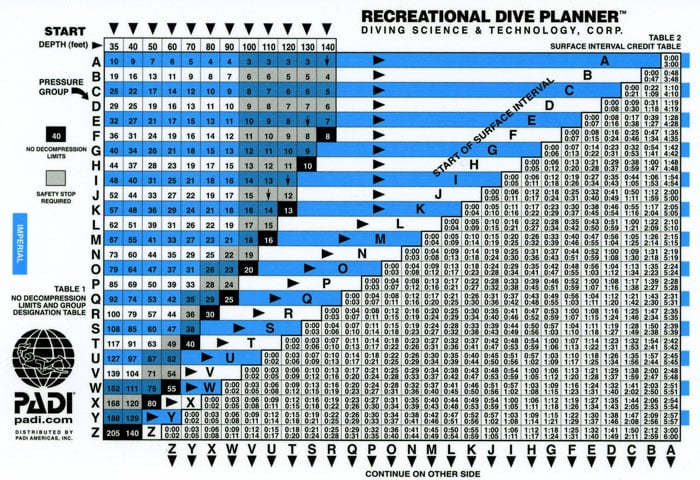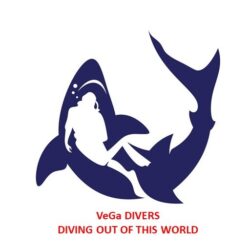Dive Tables

To prevent DCS and DCI, the US Navy released what is a called a “dive table.” Its part of your training to use and plan your dive. For those who may be unfamiliar, a standard air diving table basically lets you know how much nitrogen you will build up at any depth for any amount of time. This basic table is a “no-decompression dive table,” which means that at any depth (to 130 ft or 40m) for any time allotted on the table, you will not be required to stop and off-gas nitrogen since you have not acquired any excess in your bloodstream.
In a nutshell, you select the depth at which you plan on diving. Always use the deepest point of the dive, even if it’s only for a minute unless you are using a planning wheel which will be covered at a later date. The depths are typically listed in both feet and meters so everyone can safely understand them. Next, move down the row to the corresponding number of minutes you plan on staying. You may notice that the deeper you plan on going, the less time you have available for the actual dive. The numbers represent the maximum amount of dive time allowed per Doppler no-decompression diving limits. Any longer, and you are in a decompression dive, which is not necessarily a dangerous situation, but you must be prepared for decompression stops.
The tables help you understand how much nitrogen has been absorbed into your bloodstream, and what precautions must be taken to prevent serious illness that may prevent you from diving in the future. Going beyond the Doppler limits without proper training could prove to be fatal.
Watch Videos For RDP calculations, Kindly excuse for slight blur of images
No Decompression Limits (NDL)
The no decompression limit (NDL) is the maximum allowable dive time that you can remain at a specific depth and ascend directly to the surface without requiring staged decompression stops on the way up. Remember the higher the partial pressure of nitrogen (ppN2), the shorter the dive time (NDL).
You can use air dive tables to determine your NDL, but the best way is to consult your Personal Dive Computer (PDC) and plan the depth for your dive. It is important to know how to manually calculate NDL in case the Dive Computer is not working or has a dead battery before the dive.
The table below shows the sliding open circuit partial pressure of both oxygen and nitrogen as applied to air.
| Depth | Pressure | Oxygen (%) | Oxygen (pp) | Nitrogen (%) | Nitrogen (pp) | Total Pressure |
|---|---|---|---|---|---|---|
| Sea Level | 1 bar/ata | 21% | 0.21 | 79% | 0.79 | 1 bar/ata |
| 10 m/33 ft. | 2 bar/ata | 21% | 0.42 | 79% | 1.58 | 2 bar/ata |
| 20 m/66 ft. | 3 bar/ata | 21% | 0.63 | 79% | 2.37 | 3 bar/ata |
| 30 m/99 ft. | 4 bar/ata | 21% | 0.84 | 79% | 3.16 | 4 bar/ata |
| 40 m/132 ft. | 5 bar/ata | 21% | 1.05 | 79% | 3.95 | 5 bar/ata |
If you accidentally exceed your NDL, follow the recommended stops displayed by the PDC. If required decompression stops were omitted, exit the water. Explain your situation to the surface support (boat crew or your dive buddy, for example). Do not continue diving, breathe 100% oxygen, drink plenty of water, and monitor for signs and symptoms of DCS. Seek medical attention by contacting emergency services or the closest medical facility as soon as possible.
NEVER delay medical treatment.
Underwater Dive Time Planning
When recreational diving, it is always a good idea to plan your dive and include the maximum depth and the allowable dive time. The maximum depth may be the easiest part to determine. Consult a dive site chart or map. Note the depths indicated, or ask the local guide/dive master for details about the recommended depths.
Next, determine the maximum dive time. You have the following factors to consider that will limit your dive time.
- Exposure to the environment
- Open circuit gas supply limit
- NDL for the depth (maximum allowable dive time)
- Depth limit for your level of training
We will consider each of these one at a time, although the answer will be the most conservative time for any of the above.
Here are a few terms you should know.
- Maximum operating depth (MOD): This is usually based on the maximum depth at which the nitrox can be used.
- Calculating the MOD: For recreational only = (1.4/PaO2 in Nitrox Mix)-1×10
- Target operating depth (TOD): This is the depth the Open Water is 18 to 20 meters. Advanced open water is 30 meters -planning to dive to.
- Surface air consumption (SAC): This is calculated using the amount of gas consumed over a set time at a set depth.
- Liters per minute SAC= Bar Used X Total Cylinder Capacity Litres/ ATA= value derived/Time
- No decompression limit (NDL)
Please click the above link for the presentation over theory of RDP
